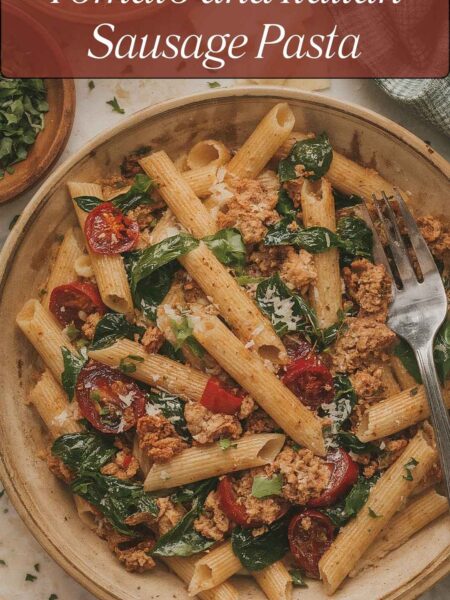There’s something about a bowl of soy sauce noodles that delivers both comfort and satisfaction. Imagine those slightly chewy strands coated in a luscious, savory sauce, mingling with fresh vegetables and aromatic garlic.
It pairs beautifully with a side of crispy spring rolls or some freshly stir-fried bok choy. When I whip up these beloved noodles, I often relish them alongside a perfectly seared chicken breast or even grilled tofu for my vegetarian friends. It’s a culinary dance of flavors that absolutely everyone can enjoy.
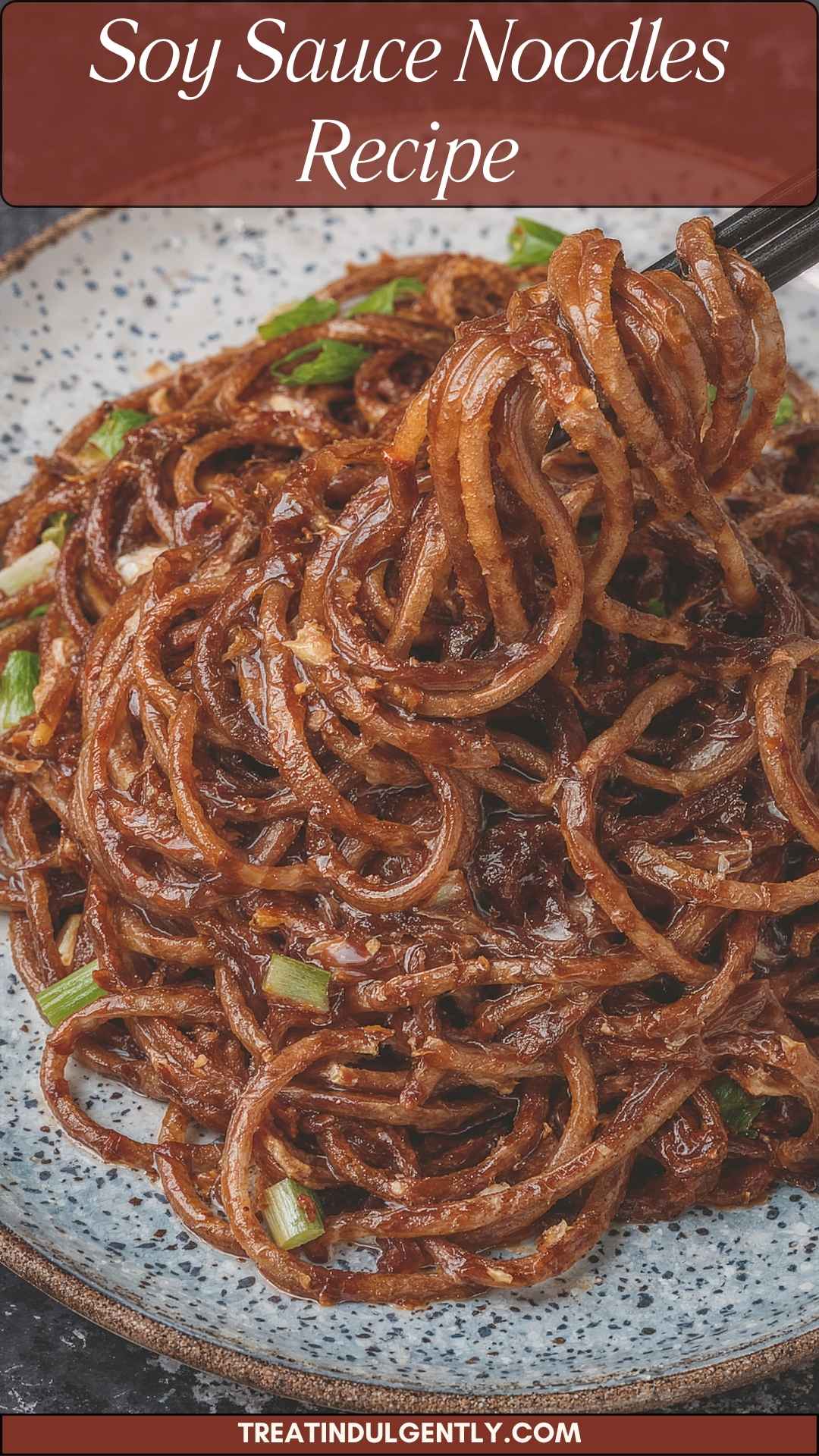
What are Soy Sauce Noodles?
Soy sauce noodles aren’t just a dish; they’re a celebration of umami flavors. At their core, they consist of noodles—typically wheat, egg, or even rice—tossed in a savory blend of soy sauces, sesame oil, and a hint of sweetness. They are easy to prepare and can be loaded with an array of vegetables and proteins, making them a wonderful addition to any meal.
Ingredients You’ll Need
To create these soy sauce noodles, here’s a solid list of ingredients you should gather:
- 6 garlic cloves, thinly sliced
- 3 stalks of green onion, cut into 2-inch sections
- 1–3 red chilies, finely chopped (adjust according to your spice preference)
- 1.5 cups fresh bean sprouts
- 450 g cooked noodles (wheat or egg noodles work best)
- 3 tbsp light soy sauce (for that classic salty balance)
- 2.5 tbsp dark soy sauce (this adds depth and rich color)
- 2 tbsp cane sugar (to bring a subtle touch of sweetness)
- 1 tbsp hoisin sauce (for a sweet-savory complexity)
- 2 tbsp toasted sesame oil (this brings in a lovely nutty aroma)
- 1 tsp rice vinegar (to brighten the dish)
- 4 tbsp vegetable broth or water (broth enhances flavor)
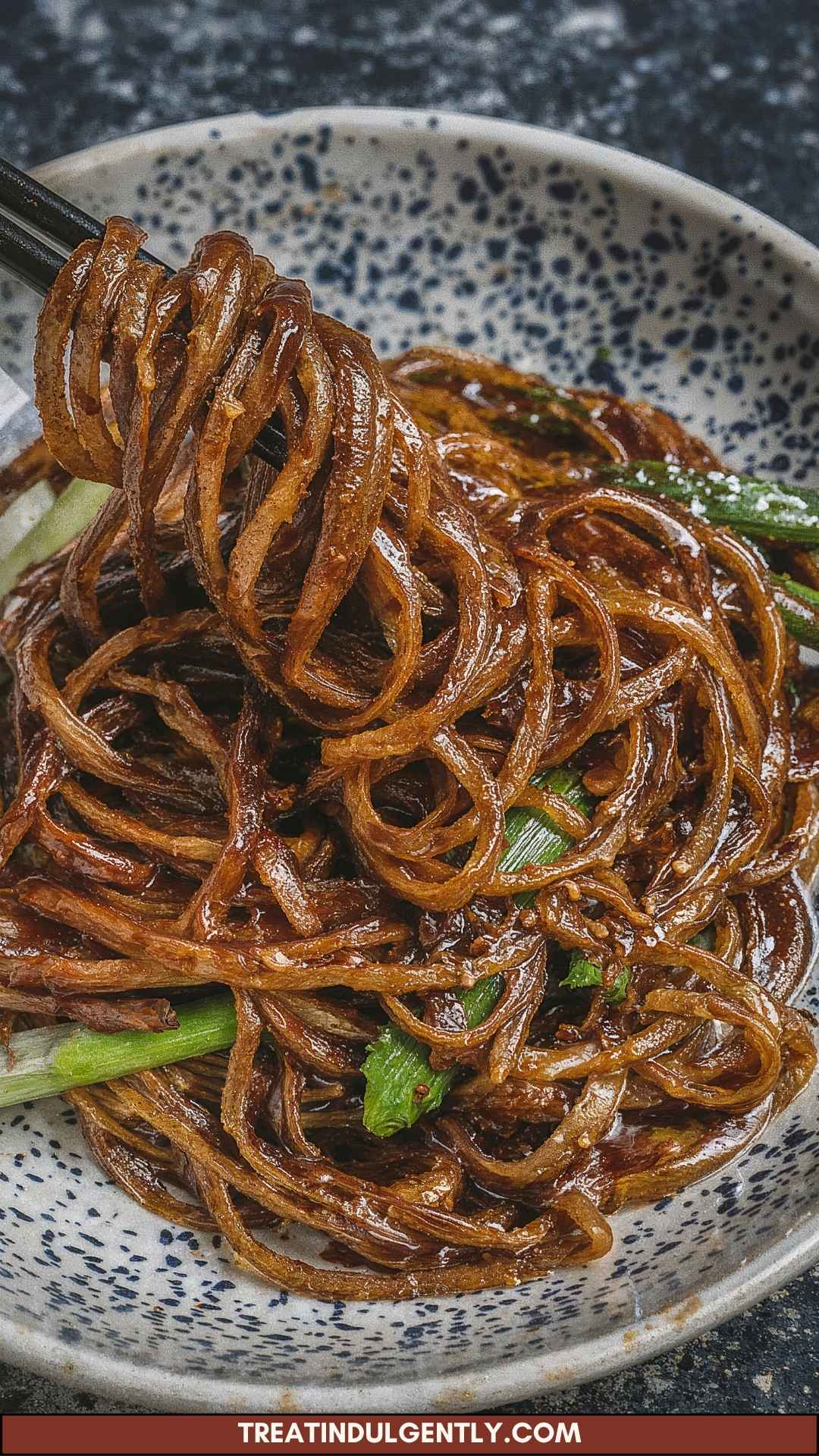
Step-By-Step Directions
Step 1: Gather Your Ingredients
Before anything else, lay out all your ingredients. Trust me, this makes the cooking process seamless. Pre-measure everything—you know, like a pro chef.
Step 2: Cook the Noodles
Bring a pot of salted water to a boil and cook your noodles according to the package instructions. Aim for al dente—it’ll give your dish the perfect texture. Drain and rinse the noodles under cold water. Set aside.
Step 3: Prepare the Aromatics
In a large skillet or wok, heat a splash of vegetable oil over medium-high heat. Toss in your sliced garlic and let it sizzlingly release its fragrance. This shouldn’t take more than a minute; watch carefully so it doesn’t burn! Add the green onions and let them cook for 30 seconds.
Step 4: Spice It Up
For added heat, stir in the finely chopped red chilies. If you enjoy a mild flavor, use fewer chilies or skip them altogether. Few things are as delightful as garlic and chilies mingling together!
Step 5: Introduce the Bean Sprouts
Add 1.5 cups of fresh bean sprouts to the pan. Stir-fry them for about 2 minutes. They should still retain their crunch, which contrasts beautifully with the noodles.
Step 6: Combine It All
Now, toss in the cooked noodles. Pour in the light soy sauce, dark soy sauce, hoisin sauce, and toasted sesame oil. Don’t forget to add the cane sugar and rice vinegar too. Mix everything well so that the noodles absorb those incredible flavors.
Step 7: Adjust Consistency
If the mixture looks a bit dry, splash in 4 tablespoons of vegetable broth or water. Give it another good toss so everything blends together. This is the magic moment where the noodles soak up all the deliciousness!
Step 8: A Final Toss
Continue to stir-fry for another minute or two. You want the noodles to heat through and become perfectly coated. Taste and adjust the seasoning if needed.
Step 9: Serve Hot
Once done, transfer your soy sauce noodles to a serving platter or individual bowls. Garnish with any remaining green onions for that extra flair.
Notes: Tips for Perfecting Soy Sauce Noodles
- Quality Matters: Use good-quality soy sauce. It profoundly impacts the flavor.
- Noodle Choice: Wheat noodles give a nice chew, while rice noodles offer a gluten-free option.
- Prep Ahead: Chop your vegetables and garlic beforehand to save time during cooking.
- Customize It: Feel free to add proteins like chicken, beef, or tofu. The world is your oyster!
- Watch the Heat: Adjust chili quantity based on your spice tolerance.
Storage Tips
Leftovers? No problem! Store any uneaten soy sauce noodles in an airtight container in the refrigerator for up to three days. When you reheat, consider adding a splash of water to prevent drying out.
It’s a carb-rich dish that works wonderfully as fuel after an active day but keep an eye on the sodium if you’re watching your intake.
Serving Suggestions
Here is where the dish really shines. Soy sauce noodles are versatile; they work beautifully with several side dishes.
- Crispy Spring Rolls: These add crunch and an extra layer of flavor. Dip them in sweet chili sauce for a treat!
- Stir-Fried Bok Choy: A healthy green on the side. It’s slightly bitter flavor pairs wonderfully with the sweetness of the noodles.
- Grilled Teriyaki Chicken: Chicken marinated and grilled to perfection complements those noodles, making for a complete meal.
- Tempura Vegetables: These add a fun crunch. They balance the soft texture of noodles deliciously.
- Sesame Fried Tofu: For my vegan and vegetarian friends, marinated tofu packed with flavor is the perfect compliment.
Alternative Substitutes for Soy Sauce Noodles
If you’re looking to switch things up, there are plenty of alternatives to mix and match:
- Tamari: This is a gluten-free alternative to soy sauce. It has a slightly richer flavor and is perfect if you need to avoid gluten.
- Coconut Aminos: Made from coconut sap, this is a popular soy sauce substitute with a sweeter taste. It’s lower in sodium too!
- Liquid Aminos: This is a product made from soybeans and water. It’s full of flavor and an excellent option.
- Miso Paste: If you happen to have miso at hand, you can dilute it in water for a unique, savory flavor.
- Homemade Soy Sauce Substitute: Combine beef or vegetable broth with vinegar, sugar, and a pinch of salt for a quick alternative.
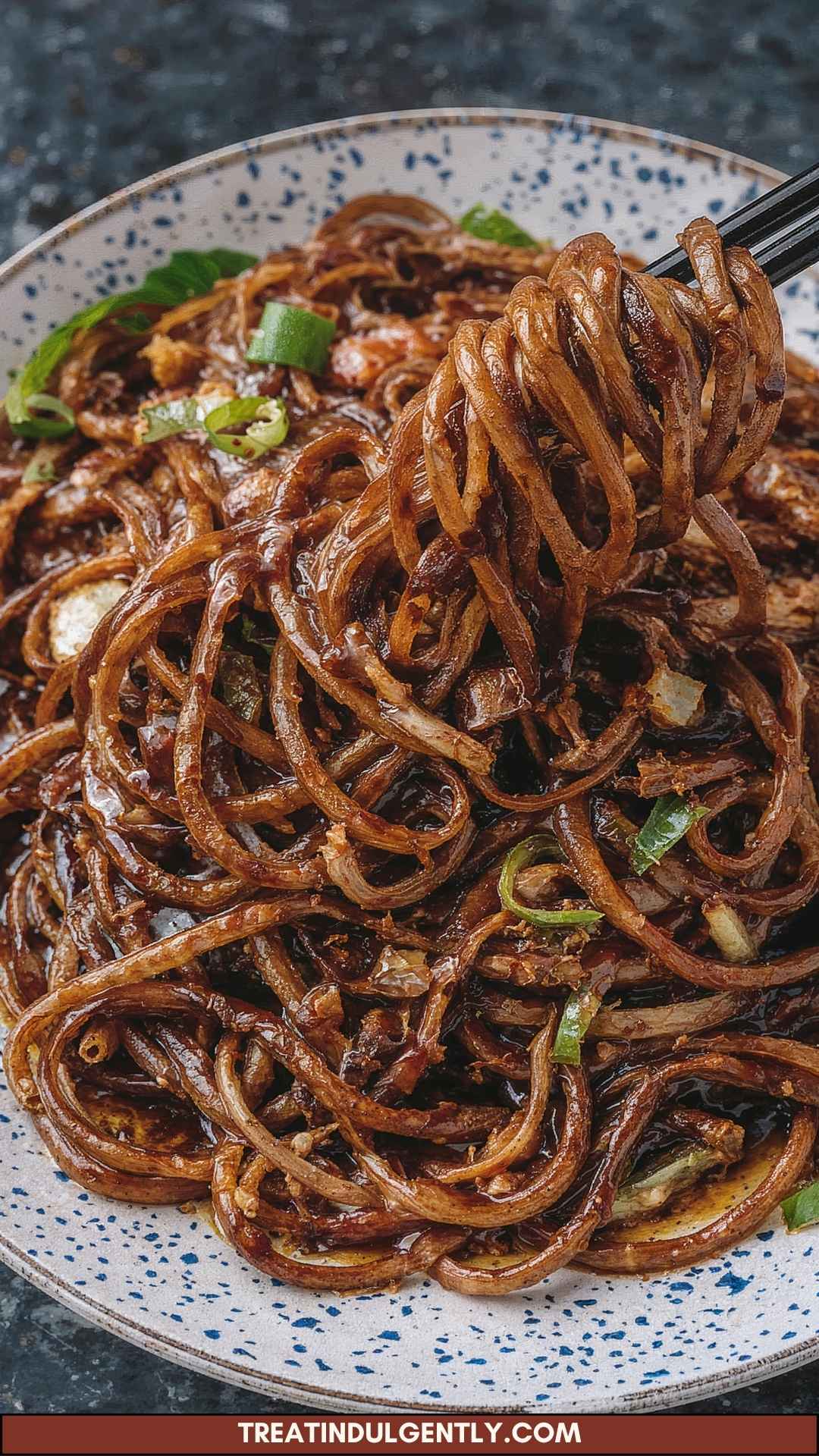
Conclusion
Making soy sauce noodles at home is an easy way to create a dish that’s layers of flavor, perfect for any occasion. The versatility of the recipe makes it fun to experiment, whether by altering ingredients, adjusting spiciness, or pairing with different sides. As someone who loves food, I find joy in perfecting this dish to share with friends and family. So whether it’s for a casual weeknight dinner or a more elaborate gathering, these soy sauce noodles prove to be a crowd-pleaser. Armed with my tips and tricks, you’re all set to wow your guests—happy cooking
You’ll also like the following recipes!
- Olive Oil Pancakes Recipe
- Sourdough Crackers With Olive Oil Herbs Recipe
- Butterfly Pea Lemonade Recipe
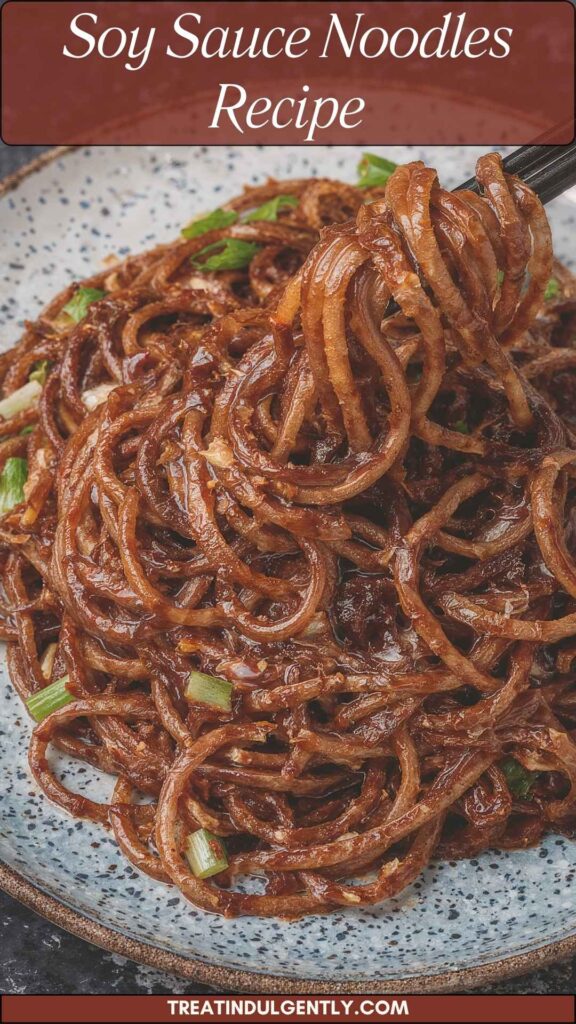
Soy Sauce Noodles Recipe – Treat Indulgently
Description
Making soy sauce noodles is simple. With the right ingredients on hand, you can create a dish that is vibrant, quick, and downright tasty. Let’s dive deeper into the step-by-step process.
Ingredients
Instructions
Step 1: Gather Your Ingredients
-
Before anything else, lay out all your ingredients. Trust me, this makes the cooking process seamless. Pre-measure everything—you know, like a pro chef.
Step 2: Cook the Noodles
-
Bring a pot of salted water to a boil and cook your noodles according to the package instructions. Aim for al dente—it’ll give your dish the perfect texture. Drain and rinse the noodles under cold water. Set aside.
Step 3: Prepare the Aromatics
-
In a large skillet or wok, heat a splash of vegetable oil over medium-high heat. Toss in your sliced garlic and let it sizzlingly release its fragrance. This shouldn't take more than a minute; watch carefully so it doesn’t burn! Add the green onions and let them cook for 30 seconds.
Step 4: Spice It Up
-
For added heat, stir in the finely chopped red chilies. If you enjoy a mild flavor, use fewer chilies or skip them altogether. Few things are as delightful as garlic and chilies mingling together!
Step 5: Introduce the Bean Sprouts
-
Add 1.5 cups of fresh bean sprouts to the pan. Stir-fry them for about 2 minutes. They should still retain their crunch, which contrasts beautifully with the noodles.
Step 6: Combine It All
-
Now, toss in the cooked noodles. Pour in the light soy sauce, dark soy sauce, hoisin sauce, and toasted sesame oil. Don't forget to add the cane sugar and rice vinegar too. Mix everything well so that the noodles absorb those incredible flavors.
Step 7: Adjust Consistency
-
If the mixture looks a bit dry, splash in 4 tablespoons of vegetable broth or water. Give it another good toss so everything blends together. This is the magic moment where the noodles soak up all the deliciousness!
Step 8: A Final Toss
-
Continue to stir-fry for another minute or two. You want the noodles to heat through and become perfectly coated. Taste and adjust the seasoning if needed.
Step 9: Serve Hot
-
Once done, transfer your soy sauce noodles to a serving platter or individual bowls. Garnish with any remaining green onions for that extra flair.
Nutrition Facts
Servings 4
- Amount Per Serving
- Calories 326kcal
- % Daily Value *
- Total Fat 11.5g18%
- Saturated Fat 1.8g9%
- Sodium 618mg26%
- Total Carbohydrate 47g16%
- Dietary Fiber 2g8%
- Sugars 10g
- Protein 9g18%
* Percent Daily Values are based on a 2,000 calorie diet. Your daily value may be higher or lower depending on your calorie needs.
Note
- Quality Matters: Use good-quality soy sauce. It profoundly impacts the flavor.
- Noodle Choice: Wheat noodles give a nice chew, while rice noodles offer a gluten-free option.
- Prep Ahead: Chop your vegetables and garlic beforehand to save time during cooking.
- Customize It: Feel free to add proteins like chicken, beef, or tofu. The world is your oyster!
- Watch the Heat: Adjust chili quantity based on your spice tolerance.



